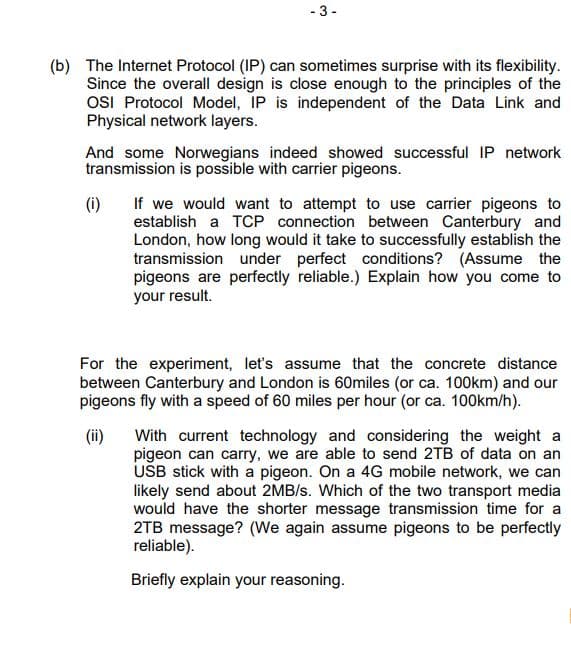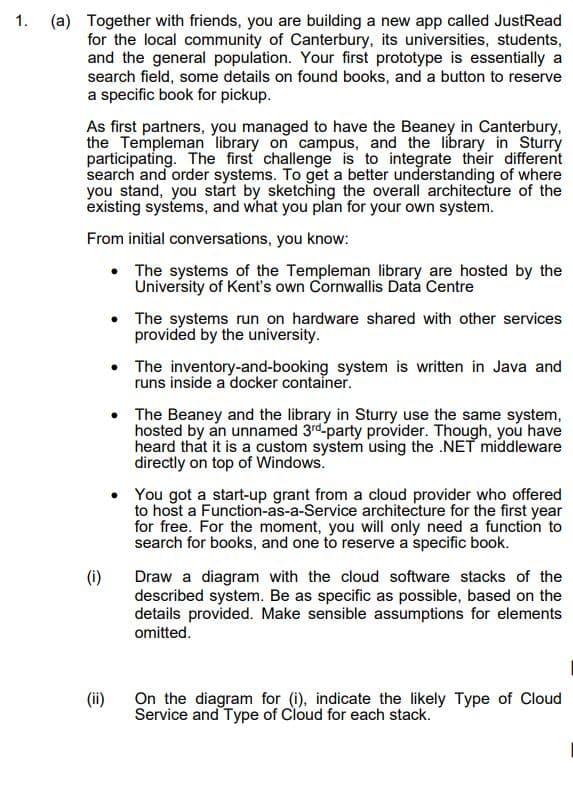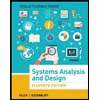(b) The Internet Protocol (IP) can sometimes surprise with its flexibility. Since the overall design is close enough to the principles of the OSI Protocol Model, IP is independent of the Data Link and Physical network layers. And some Norwegians indeed showed successful IP network transmission is possible with carrier pigeons. If we would want to attempt to use carrier pigeons to establish a TCP connection between Canterbury and London, how long would it take to successfully establish the transmission under perfect conditions? (Assume the pigeons are perfectly reliable.) Explain how you come to your result. (i) For the experiment, let's assume that the concrete distance between Canterbury and London is 60miles (or ca. 100km) and our pigeons fly with a speed of 60 miles per hour (or ca. 100km/h). (ii) With current technology and considering the weight a pigeon can carry, we are able to send 2TB of data on an USB stick with a pigeon. On a 4G mobile network, we can likely send about 2MB/s. Which of the two transport media would have the shorter message transmission time for a 2TB message? (We again assume pigeons to be perfectly reliable). Briefly explain your reasoning.
(b) The Internet Protocol (IP) can sometimes surprise with its flexibility. Since the overall design is close enough to the principles of the OSI Protocol Model, IP is independent of the Data Link and Physical network layers. And some Norwegians indeed showed successful IP network transmission is possible with carrier pigeons. If we would want to attempt to use carrier pigeons to establish a TCP connection between Canterbury and London, how long would it take to successfully establish the transmission under perfect conditions? (Assume the pigeons are perfectly reliable.) Explain how you come to your result. (i) For the experiment, let's assume that the concrete distance between Canterbury and London is 60miles (or ca. 100km) and our pigeons fly with a speed of 60 miles per hour (or ca. 100km/h). (ii) With current technology and considering the weight a pigeon can carry, we are able to send 2TB of data on an USB stick with a pigeon. On a 4G mobile network, we can likely send about 2MB/s. Which of the two transport media would have the shorter message transmission time for a 2TB message? (We again assume pigeons to be perfectly reliable). Briefly explain your reasoning.
Systems Analysis and Design (Shelly Cashman Series) (MindTap Course List)
11th Edition
ISBN:9781305494602
Author:Scott Tilley, Harry J. Rosenblatt
Publisher:Scott Tilley, Harry J. Rosenblatt
ChapterTPB: Toolkit Part B
Section: Chapter Questions
Problem 2DT
Related questions
Question

Transcribed Image Text:- 3 -
(b) The Internet Protocol (IP) can sometimes surprise with its flexibility.
Since the overall design is close enough to the principles of the
OSI Protocol Model, IP is independent of the Data Link and
Physical network layers.
And some Norwegians indeed showed successful IP network
transmission is possible with carrier pigeons.
(i)
If we would want to attempt to use carrier pigeons to
establish a TCP connection between Canterbury and
London, how long would it take to successfully establish the
transmission under perfect conditions? (Assume the
pigeons are perfectly reliable.) Explain how you come to
your result.
For the experiment, let's assume that the concrete distance
between Canterbury and London is 60miles (or ca. 100km) and our
pigeons fly with a speed of 60 miles per hour (or ca. 100km/h).
(ii)
With current technology and considering the weight a
pigeon can carry, we are able to send 2TB of data on an
USB stick with a pigeon. On a 4G mobile network, we can
likely send about 2MB/s. Which of the two transport media
would have the shorter message transmission time for a
2TB message? (We again assume pigeons to be perfectly
reliable).
Briefly explain your reasoning.

Transcribed Image Text:1. (a) Together with friends, you are building a new app called JustRead
for the local community of Canterbury, its universities, students,
and the general population. Your first prototype is essentially a
search field, some details on found books, and a button to reserve
a specific book for pickup.
As first partners, you managed to have the Beaney in Canterbury,
the Templeman library on campus, and the library in Sturry
participating. The first challenge is to integrate their different
search and order systems. To get a better understanding of where
you stand, you start by sketching the overall architecture of the
existing systems, and what you plan for your own system.
From initial conversations, you know:
The systems of the Templeman library are hosted by the
University of Kent's own Cornwallis Data Centre
The systems run on hardware shared with other services
provided by the university.
The inventory-and-booking system is written in Java and
runs inside a docker container.
• The Beaney and the library in Sturry use the same system,
hosted by an unnamed 3rd-party provider. Though, you have
heard that it is a custom system using the .NET middleware
directly on top of Windows.
You got a start-up grant from a cloud provider who offered
to host a Function-as-a-Service architecture for the first year
for free. For the moment, you will only need a function to
search for books, and one to reserve a specific book.
(i)
Draw a diagram with the cloud software stacks of the
described system. Be as specific as possible, based on the
details provided. Make sensible assumptions for elements
omitted.
(ii)
On the diagram for (i), indicate the likely Type of Cloud
Service and Type of Cloud for each stack.
Expert Solution
This question has been solved!
Explore an expertly crafted, step-by-step solution for a thorough understanding of key concepts.
Step by step
Solved in 3 steps

Knowledge Booster
Learn more about
Need a deep-dive on the concept behind this application? Look no further. Learn more about this topic, computer-science and related others by exploring similar questions and additional content below.Recommended textbooks for you

Systems Analysis and Design (Shelly Cashman Serie…
Computer Science
ISBN:
9781305494602
Author:
Scott Tilley, Harry J. Rosenblatt
Publisher:
Cengage Learning

Systems Analysis and Design (Shelly Cashman Serie…
Computer Science
ISBN:
9781305494602
Author:
Scott Tilley, Harry J. Rosenblatt
Publisher:
Cengage Learning